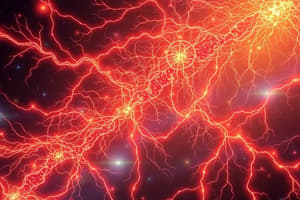Podcast
Questions and Answers
What is the main function of afferent sensory pathways?
What is the main function of afferent sensory pathways?
- To carry sensory information from receptors to the central nervous system (correct)
- To connect the brain to peripheral sensory organs
- To process and interpret sensory information at the spinal cord
- To transmit motor commands from the brain to muscles
Which of the following pathways is responsible for transmitting fine touch and proprioception?
Which of the following pathways is responsible for transmitting fine touch and proprioception?
- Dorsal Column-Medial Lemniscal Pathway (correct)
- Auditory Pathway
- Trigeminothalamic Pathway
- Spinothalamic Tract
How do sensory receptors convert environmental stimuli into electrical signals?
How do sensory receptors convert environmental stimuli into electrical signals?
- By converting stimulus energy into action potentials (correct)
- By altering the ion balance in adjacent neurons
- Through signal transduction involving chemical synapses
- By generating muscle contractions
Which sensory modality bypasses the thalamus in its pathway?
Which sensory modality bypasses the thalamus in its pathway?
What does the homunculus model illustrate regarding sensory input?
What does the homunculus model illustrate regarding sensory input?
What might damage to afferent pathways lead to?
What might damage to afferent pathways lead to?
What role does multisensory integration play in sensory processing?
What role does multisensory integration play in sensory processing?
Which type of sensory modality includes temperature and pain sensation?
Which type of sensory modality includes temperature and pain sensation?
Flashcards are hidden until you start studying
Study Notes
Afferent Sensory Pathways
-
Definition: Afferent sensory pathways are neural pathways that carry sensory information from sensory receptors to the central nervous system (CNS).
-
Components:
- Sensory Receptors: Specialized cells that detect environmental stimuli (e.g., light, sound, touch).
- Afferent Neurons: Neurons that transmit sensory information from receptors to the CNS.
- Spinal Cord and Brainstem: Major relay stations for processing sensory information before it reaches the brain.
-
Types of Sensory Modalities:
- Somatosensory:
- Touch, temperature, pain, and proprioception.
- Pathways: Dorsal columns and spinothalamic tracts.
- Visual:
- Light detection and processing.
- Pathway: Retina → optic nerve → thalamus (lateral geniculate nucleus) → visual cortex.
- Auditory:
- Sound detection.
- Pathway: Cochlea → auditory nerve → brainstem → thalamus (medial geniculate nucleus) → auditory cortex.
- Olfactory:
- Smell detection.
- Pathway: Olfactory epithelium → olfactory bulb → olfactory cortex (bypasses thalamus).
- Gustatory:
- Taste detection.
- Pathway: Taste buds → facial/glossopharyngeal nerves → brainstem → thalamus → gustatory cortex.
- Somatosensory:
-
Signal Transduction:
- Sensory receptors convert stimulus energy into electrical signals (action potentials).
- Encoding of stimulus intensity and duration is achieved through frequency coding and temporal coding.
-
Ascending Pathways:
- Dorsal Column-Medial Lemniscal Pathway: Transmits fine touch and proprioception.
- Spinothalamic Tract: Transmits pain and temperature sensations.
- Trigeminothalamic Pathway: Carries sensory information from the face.
-
Cortex Representation:
- Sensory information is processed in specialized cortical areas (e.g., primary sensory cortices).
- Homunculus model illustrates spatial organization of sensory input in the somatosensory cortex.
-
Integration and Interpretation:
- Sensory information is integrated with past experiences, emotions, and cognitive processes in higher cortical areas.
- Multisensory integration enhances perception and response to stimuli.
-
Pathway Disorders:
- Damage to afferent pathways can lead to sensory deficits (e.g., neuropathy, agnosia).
- Clinical assessments often involve testing sensory modalities to identify specific pathway dysfunctions.
Afferent Sensory Pathways
- Afferent sensory pathways transmit sensory information from receptors to the central nervous system (CNS).
- Sensory receptors are specialized cells responsible for detecting environmental stimuli such as light, sound, and touch.
- Afferent neurons convey sensory information from these receptors to the CNS for processing.
- The spinal cord and brainstem act as crucial relay stations, facilitating sensory information transmission before reaching the brain.
Types of Sensory Modalities
-
Somatosensory:
- Involves touch, temperature, pain, and proprioception.
- Key pathways include the dorsal columns for fine touch and the spinothalamic tracts for pain and temperature.
-
Visual:
- Focuses on light detection and processing via the retina, optic nerve, thalamus (lateral geniculate nucleus), and visual cortex.
-
Auditory:
- Concerned with sound detection, following a pathway from the cochlea to the auditory cortex through the auditory nerve and brainstem.
-
Olfactory:
- Involves smell detection, with the olfactory pathway connecting the olfactory epithelium to the olfactory bulb and olfactory cortex, bypassing the thalamus.
-
Gustatory:
- Relates to taste detection, using a pathway from taste buds through facial/glossopharyngeal nerves to the brainstem, thalamus, and gustatory cortex.
Signal Transduction and Pathways
- Sensory receptors convert environmental stimulus energy into electrical signals (action potentials).
- Frequency coding and temporal coding are mechanisms for encoding stimulus intensity and duration.
Ascending Pathways
- Dorsal Column-Medial Lemniscal Pathway: Responsible for transmitting fine touch and proprioception signals.
- Spinothalamic Tract: Carries pain and temperature sensory information.
- Trigeminothalamic Pathway: Transmits sensory data from the face to the CNS.
Cortex Representation and Integration
- Sensory information is processed in specialized cortical areas, including primary sensory cortices which allow for distinct sensory experiences.
- The homunculus model illustrates the spatial organization of sensory input within the somatosensory cortex.
- Higher cortical areas integrate sensory information with past experiences, emotions, and cognitive processes, enhancing perception through multisensory integration.
Pathway Disorders
- Damage to afferent pathways can result in sensory deficits such as neuropathy and agnosia.
- Clinical assessments focus on testing various sensory modalities to identify pathways affected by dysfunction.
Studying That Suits You
Use AI to generate personalized quizzes and flashcards to suit your learning preferences.




